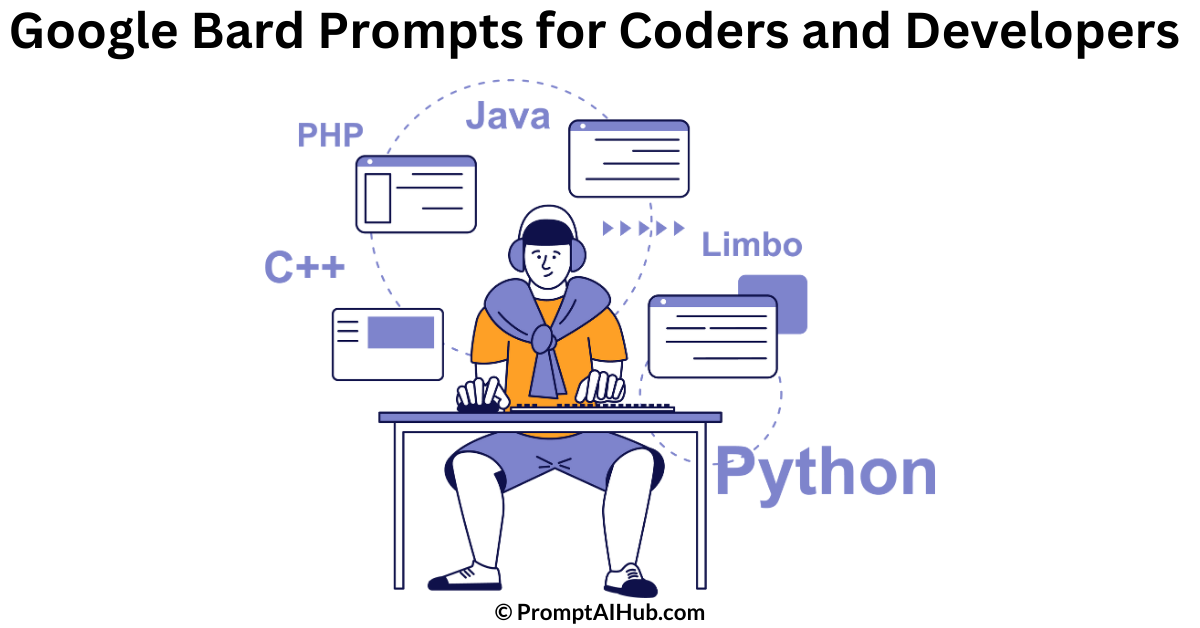Are you a developer or coder looking to sharpen your skills and stand out in the competitive tech landscape? Well, you’re in the right place! In this article, we’ve compiled 107 Google Bard Prompts specifically for developers and coders. Whether you’re seeking to enhance your coding expertise or improve your problem-solving skills, this comprehensive resource will equip you with the prompts you need. So, take a moment to read through, and discover how these prompts can be your secret weapon for coding success.
Visit Here: Google Bard App Development Update (Expected Release In 2024)
All Google Bard Prompts for Developers
1. Prompt: You’re building a mobile app that relies on geolocation services. Create a Python function that takes a latitude and longitude as input and returns the nearest city using the Google Maps Geocoding API. Remember to handle potential errors.
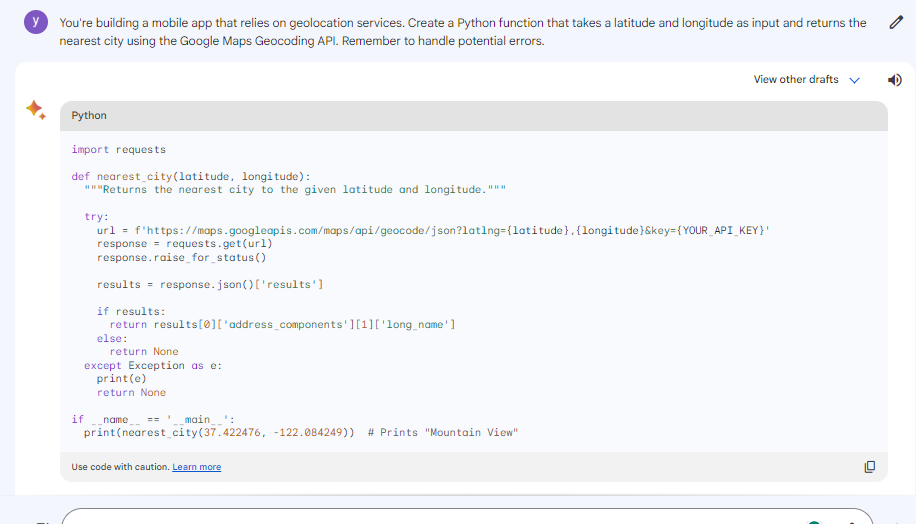
2. Prompt: Write a JavaScript function to asynchronously fetch data from a REST API using the Fetch API. You need to handle authentication with an API key and parse the response, which is in JSON format. Ensure it’s a reusable function that can be used in various parts of your application.
3. Prompt: Design an SQL database schema for an e-commerce platform. Define tables for products, customers, orders, and payments. Include data types, relationships, and constraints.
4. Prompt: Create a responsive HTML and CSS template for a personal blog. Your design should include a navigation bar, a main content area, and a sidebar. Ensure it looks good on both desktop and mobile devices.
5. Prompt: Implement user authentication in a Node.js application using Passport.js. Configure it to support local (username and password) and social (Google, Facebook) authentication strategies. Write detailed steps for integrating these strategies into your application.
6. Prompt: You need to optimize the performance of a web page that loads slowly. Describe the steps you would take to identify performance bottlenecks, using tools like Lighthouse or Chrome DevTools. Explain how you would address these issues, such as optimizing images or minimizing JavaScript execution time.
7. Prompt: Develop a Python script that automates the process of resizing and watermarking images using the Pillow library. The script should take a folder of images, apply a watermark with the specified text, and save the watermarked images to an output folder.
8. Prompt: You’re working on a microservices architecture using Docker containers. Describe the best practices for container orchestration and management, including load balancing, service discovery, and scaling. Use Docker Compose and Kubernetes as examples.
9. Prompt: Build a basic CRUD (Create, Read, Update, Delete) RESTful API in Ruby on Rails for managing a collection of books. Explain how to set up routes, controllers, and database models. Ensure proper request and response handling for each CRUD operation.
10. Prompt: Create a Python script that scrapes data from a website using the Beautiful Soup library. Provide step-by-step instructions on how to select specific HTML elements, extract data, and save it to a CSV file. Include error handling for possible network issues or invalid HTML structures.
11. Prompt: You’re tasked with building a real-time chat application using WebSockets. Write a Node.js server that handles WebSocket connections, manages multiple chat rooms, and enables users to send and receive messages in real time. Include user authentication and room management.
12. Prompt: Develop a Python script to automate database backups for a PostgreSQL database. Describe the steps to schedule regular backups, compress the backup files, and store them securely on an external server using SSH.
13. Prompt: Create a responsive, mobile-first landing page using HTML, CSS, and JavaScript. The page should feature a sign-up form with client-side validation and a countdown timer for an upcoming event. Ensure it’s optimized for performance.
14. Prompt: Design an authentication and authorization system for a microservices architecture using JSON Web Tokens (JWT). Explain how to generate, verify, and refresh tokens, and how to handle user roles and permissions in a distributed environment.
15. Prompt: Write a script in Python that automates the deployment of a web application to a cloud platform like AWS or Google Cloud. Include steps for provisioning resources, deploying code, and configuring necessary services such as databases and load balancers.
16. Prompt: Implement a recommendation system using collaborative filtering in a Python application. Describe the matrix factorization technique and how it can be applied to provide personalized movie recommendations based on user preferences.
17. Prompt: Develop a RESTful API in Ruby on Rails for a task management application. The API should allow users to create, update, and delete tasks, and should support filtering and sorting. Explain how to handle authentication and versioning in the API.
18. Prompt: Build a multi-step registration form in React. The form should include client-side validation, dynamic rendering of steps, and the ability to save the user’s progress and resume registration later. Use state management and component composition effectively.
19. Prompt: Create a Dockerized microservices architecture for a web application. Define the Dockerfiles and Docker Compose configuration for multiple services, including a front-end, back-end, and a database. Explain best practices for containerization and orchestration.
20. Prompt: Write a Python script to analyze a large log file (e.g., Apache access logs) and extract useful information, such as the most frequent IP addresses, user agents, and request URLs. Use regular expressions and data structures for efficient analysis.
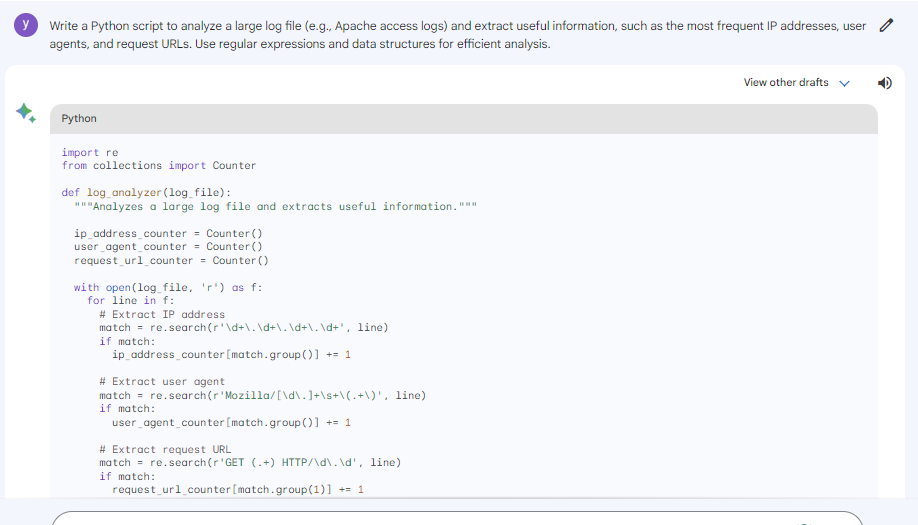
21. Prompt: Develop a cross-platform mobile app using a framework like React Native or Flutter. The app should have authentication, data retrieval from a REST API, offline capabilities, and the ability to upload images. Explain how to maintain a consistent user experience across both iOS and Android.
22. Prompt: Design a scalable and fault-tolerant architecture for a social media platform. Include components for user profiles, posts, comments, and real-time notifications. Describe how you would handle high traffic and ensure data consistency.
23. Prompt: Implement a two-factor authentication (2FA) system in a Node.js application using time-based one-time passwords (TOTP). Describe the workflow, including the generation of QR codes for authenticator apps, and validate 2FA codes.
24. Prompt: Create a Python script to extract structured data from unstructured text using natural language processing (NLP). Use a library like spaCy or NLTK to perform tasks such as entity recognition or sentiment analysis on a given text corpus.
25. Prompt: Build a secure file upload and storage system in a web application using AWS S3. Explain how to handle file uploads, store them in S3 buckets, and serve them securely with proper access controls.
26. Prompt: Develop a real-time dashboard using a JavaScript framework like React or Vue. The dashboard should display live data updates, offer customizable widgets, and allow users to save their dashboard layouts. Implement WebSocket or server-sent events for real-time updates.
27. Prompt: Design and implement a database schema for a content management system (CMS). Define tables for content types, categories, tags, and user-generated content. Explain how to establish relationships between these tables and optimize queries for performance.
28. Prompt: Write a Python script that monitors server resource usage and sends alerts when predefined thresholds are exceeded. Use a library like psutil to gather system metrics and a messaging service (e.g., Slack or email) for notifications.
29. Prompt: Create a web application that provides user-generated reviews and ratings for products. Implement user authentication, allow users to submit reviews, and display aggregated ratings. Explain how to prevent abuse, such as fake reviews.
30. Prompt: Develop a GraphQL API using Node.js and Apollo Server for a blogging platform. Define the schema for posts, comments, and users, and enable queries and mutations to create, read, update, and delete data. Provide detailed examples of queries and mutations.
31. Prompt: You’re building a cross-platform desktop application using Electron. Write code in JavaScript to create a multi-window app that communicates between windows using Electron’s IPC (Inter-Process Communication) mechanism. Show how to pass data and trigger actions between windows.
32. Prompt: Design a caching strategy for a high-traffic e-commerce website. Explain how you would implement caching at various layers (browser, server, and database) to improve performance and reduce load on the database.
33. Prompt: Develop a Python script that automates the extraction of data from unstructured PDF documents. Use libraries like PyPDF2 or pdfplumber to extract text and structured data from PDFs. Provide examples and handling for variations in document structure.
34. Prompt: You’re tasked with creating a recommendation engine for an online marketplace. Describe the architecture and algorithms you would use to provide personalized product recommendations to users based on their browsing and purchase history.
35. Prompt: Build a responsive, mobile-first web application for managing personal finances. Include features such as expense tracking, budgeting, and generating financial reports. Utilize a JavaScript framework of your choice.
36. Prompt: Implement user authentication and authorization in a Node.js application using OAuth 2.0. Describe the flow for user login and authorization with a third-party identity provider (e.g., Google or Facebook) and how to secure API endpoints.
37. Prompt: Create a CI/CD (Continuous Integration/Continuous Deployment) pipeline for a web application using Jenkins. Explain how to automate the building, testing, and deployment processes, integrating it with a version control system.
38. Prompt: Design a database schema for a social networking platform, focusing on user profiles, friend connections, posts, comments, and likes. Include efficient queries for displaying users’ feeds and managing connections.
39. Prompt: Write a Python script that utilizes the Twitter API to fetch and analyze tweets containing specific keywords. Extract relevant data such as tweet content, user information, and engagement metrics. Present the data in a meaningful format.
40. Prompt: Develop a custom WordPress plugin that adds a new functionality to WordPress. Explain how to create the plugin, including setting up hooks, adding custom post types or fields, and integrating it into the WordPress admin panel.
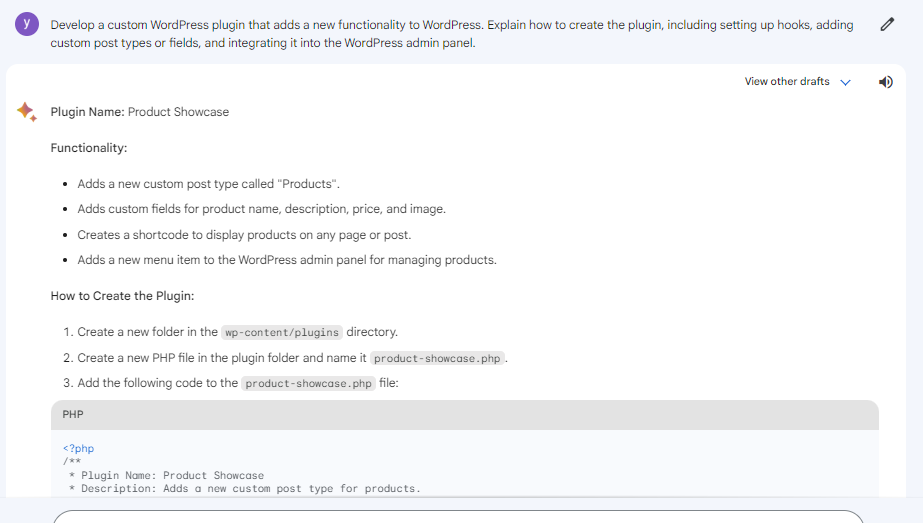
41. Prompt: Create a data visualization dashboard using D3.js for displaying real-time stock market data. Implement interactive charts, price updates, and historical data analysis. Provide code snippets for the key components of the dashboard.
42. Prompt: Build a microservices-based architecture for a video streaming platform. Describe the services needed for video upload, transcoding, storage, and user subscriptions. Discuss the communication between these services and their scalability.
43. Prompt: Design an error handling and logging strategy for a web application. Explain how to catch and report errors, log important information, and handle different types of errors, such as client-side and server-side errors.
44. Prompt: Write a Python script to scrape data from a website that requires authentication. Implement a web scraping bot that can log in, navigate the site, and extract structured information. Include handling for CAPTCHAs and rate limiting.
45. Prompt: Develop a mobile app with geolocation features using Flutter. Create a location-based app that allows users to search for nearby points of interest and display them on a map. Explain how to access the device’s location services and integrate maps.
46. Prompt: Implement a real-time chat widget for a website using WebSockets and React. Show how to set up the server, establish WebSocket connections, and enable chat functionality with user-to-user messaging and notifications.
47. Prompt: Design a secure RESTful API authentication system using JSON Web Tokens (JWT) and OAuth 2.0. Explain how to issue and verify tokens, handle token expiration, and grant specific permissions to users.
48. Prompt: Create a Python script for data preprocessing and feature engineering in a machine learning project. Include tasks like handling missing data, encoding categorical variables, and normalizing or scaling features.
49. Prompt: Build a recommendation system for a music streaming service using collaborative filtering. Explain user-based and item-based approaches, and describe how to provide song recommendations based on user listening history.
50. Prompt: Develop a web application that integrates with a payment gateway for online purchases. Describe the steps to securely process payments, including payment authorization, handling payment errors, and managing transaction records.
Visit Here: 37 Best Free Chrome Extensions For Google Bard (Tried & Tested)
All Google Bard Prompts for Coding:
1. Prompt: You’re tasked with implementing a data structure to efficiently find the Kth largest element in an unsorted array. Write a Python function that accomplishes this using a placeholder sorting algorithm and analyze its time complexity.
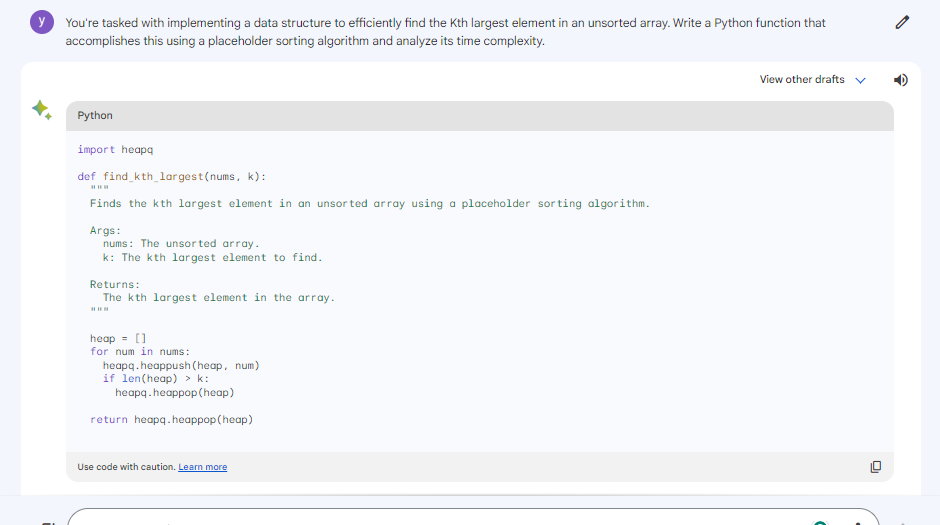
2. Prompt: Develop a RESTful API for a blogging platform using your preferred backend framework. Create endpoints for creating, updating, and deleting blog posts, as well as retrieving posts by category. Explain how to implement pagination and authentication with temporary placeholders.
3. Prompt: Write a JavaScript function that takes an array of integers as input and returns the longest increasing subarray. Describe the algorithm, and ensure it handles edge cases and provides the subarray’s start and end indices.
4. Prompt: Create a Python script that simulates a basic banking system. Design classes and functions to represent customers, accounts, and transactions. Use placeholders for database operations to deposit and withdraw funds, and display account balances.
5. Prompt: You’re building a web application, and you need to implement user authentication and authorization. Explain how you would use placeholders for user sessions, secure password storage, and role-based access control in your chosen framework.
6. Prompt: Design a class hierarchy for a simple 2D graphics library in Python. Define classes for shapes like circles, rectangles, and triangles. Include methods to calculate the area and perimeter for each shape with placeholder formulas.
7. Prompt: Develop a command-line tool in a language of your choice that converts a CSV file into a JSON file and vice versa. Implement placeholders for reading and writing the data and handle different data structures and delimiters.
8. Prompt: Create a Python script that uses regular expressions to validate email addresses. Explain how you would validate common email patterns, handle edge cases, and provide feedback for users when an email address is invalid.
9. Prompt: You’re tasked with implementing a basic sorting algorithm for a list of integers. Write a detailed algorithm in Python with placeholders and explain its time and space complexity. Discuss potential improvements and trade-offs.
10. Prompt: Design a class structure for a library management system. Create classes for books, patrons, and transactions. Use placeholders for checking out and returning books, handling due dates, and tracking overdue fines.
11. Prompt: Write a Python function that calculates the factorial of a positive integer. Ensure the function handles edge cases like 0 and uses recursion for computation. Provide code for both the recursive and iterative versions.
12. Prompt: Create a JavaScript class for a doubly-linked list. Include methods for adding, removing, and searching for elements. Implement a feature to reverse the list in place.
13. Prompt: Design a SQL query to retrieve the top N most recently registered users from a user database, ordered by their registration date. Consider the database schema with fields like username, email, and registration date.
14. Prompt: Implement a binary search algorithm in C++ to search for a target value in a sorted array. Describe the algorithm, including how it compares to linear search in terms of efficiency and when to use it.
15. Prompt: Develop a RESTful API in Node.js using Express for managing a library of books. Include endpoints for listing all books, adding new books, updating book details, and deleting books. Ensure proper request and response handling.
16. Prompt: Write a Python program that generates a Fibonacci sequence with the first N numbers. Optimize the program to use memoization or dynamic programming to reduce computation time.
17. Prompt: Create a JavaScript function that validates an email address using regular expressions. Explain the regular expression pattern and how to check if the provided email is valid according to the pattern.
18. Prompt: Design a class hierarchy in Java for geometric shapes, including circles, rectangles, and triangles. Implement methods for calculating the area and perimeter for each shape, and demonstrate polymorphism in action.
19. Prompt: Write a Python script to parse and process a JSON file containing data about movies and their ratings. Calculate the average rating for each movie and generate a report with the results.
20. Prompt: Develop a Python program that simulates a basic inventory management system. Define classes for products and inventory, and implement features for adding, updating, and displaying product information in the inventory.
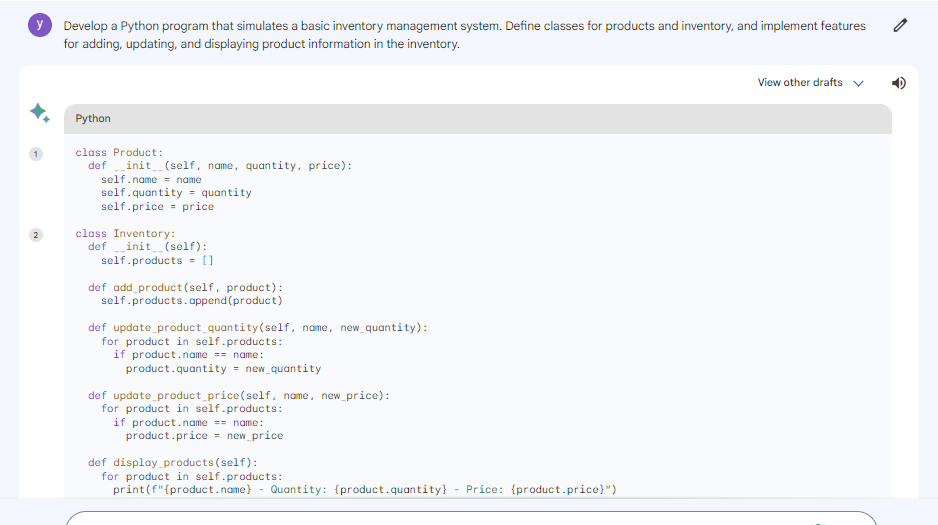
21. Prompt: Write a Python function that checks if a given string is a palindrome. Ensure that the function handles different cases (e.g., ignoring spaces, and special characters) and provides a clear explanation of the algorithm used.
22. Prompt: Implement a sorting algorithm in Java, such as QuickSort or MergeSort. Describe the algorithm’s time complexity and space complexity, and provide a working code example.
23. Prompt: Design a database schema for an online forum. Define tables for users, posts, comments, and categories. Specify relationships between tables and include foreign keys and primary keys.
24. Prompt: Create a C++ program to solve the classic “Towers of Hanoi” problem. Explain the problem’s rules, and the recursive algorithm used to solve it, and provide a step-by-step demonstration of moving disks between pegs.
25. Prompt: Develop a Python script to scrape data from a website using the Beautiful Soup library. Include steps to navigate the website, select specific HTML elements, and extract information into a structured format.
26. Prompt: Build a RESTful API in Ruby on Rails for a task management application. Define endpoints for creating, updating, and deleting tasks, and demonstrate how to handle authentication and versioning.
27. Prompt: Write a JavaScript function to convert a given number from decimal to binary representation. Include error handling for non-numeric input and demonstrate the conversion process.
28. Prompt: Design a class in Python for a simple linked list data structure. Include methods for inserting, deleting, and searching for nodes in the list, and provide clear documentation for usage.
29. Prompt: Create a Java program that simulates a basic e-commerce shopping cart system. Implement classes for products, shopping carts, and customers, and demonstrate how to add, remove, and calculate totals for items in the cart.
30. Prompt: Develop a Python script that calculates the prime factors of a given integer. Explain the algorithm used to find the prime factors and provide examples for different input values.
31. Prompt: Write a PHP script to handle file uploads and validate file types and sizes. Ensure secure handling of uploaded files and describe the steps to save the uploaded files to a server directory.
32. Prompt: Design a RESTful API in Node.js using Express for managing user profiles. Define endpoints for creating, updating, and retrieving user information, and implement authentication and authorization.
33. Prompt: Create a JavaScript program that simulates a basic ATM machine. Define classes for accounts and the ATM, and implement features for checking balances, making deposits, and withdrawing funds.
34. Prompt: Write a Python program that generates a random password based on user-defined criteria (e.g., length, complexity, special characters). Provide options for both CLI and GUI interfaces.
35. Prompt: Implement a binary tree data structure in C# and provide functions for tree traversal (e.g., in-order, pre-order, post-order). Explain the purpose of each traversal and provide code examples.
36. Prompt: Design a class in Python for a basic calculator that can perform arithmetic operations (addition, subtraction, multiplication, division). Include error handling for division by zero.
37. Prompt: Create a JavaScript function to validate a credit card number using the Luhn algorithm. Explain how the algorithm works and how to determine if a credit card number is valid.
38. Prompt: Develop a Python program that reads and analyzes a CSV file containing sales data. Calculate the total sales, and average sales, and generate reports based on specific criteria (e.g., highest sales).
39. Prompt: Write a Java program to implement a basic text-based adventure game. Define classes for game characters, items, and locations. Create a game loop and provide examples of player interactions within the game.
40. Prompt: Implement a search algorithm in Python, such as binary search or linear search, to find a specific element in a sorted or unsorted list. Describe the algorithm’s strengths and weaknesses, and provide working code examples.
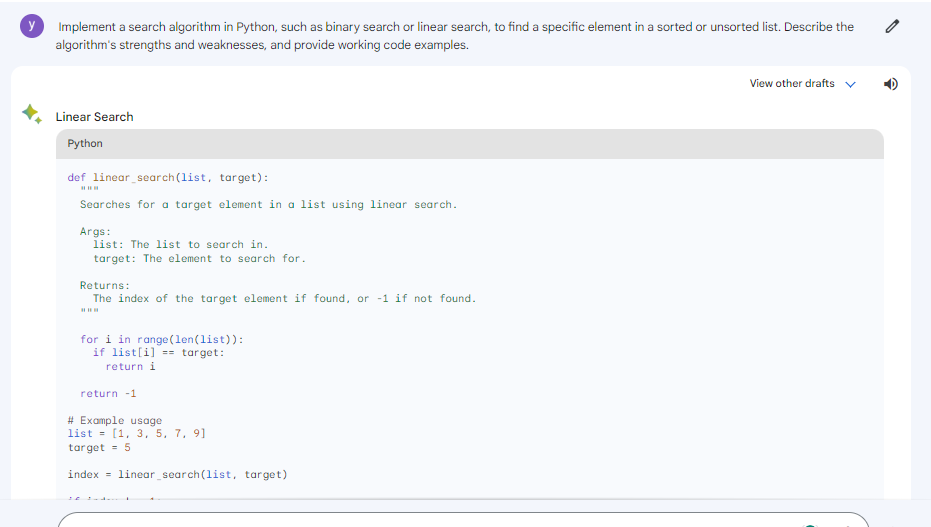
31. Prompt: Develop a Python script to parse and analyze log files from a web server. Extract relevant information, such as IP addresses, URLs, and response codes. Calculate statistics like the most common IP addresses and URLs.
32. Prompt: Write a Java program that simulates a simple banking system with account creation, balance checking, deposits, and withdrawals. Ensure thread safety in the application and describe how you achieved it.
33. Prompt: Design a class hierarchy in C++ for 2D and 3D shapes, such as circles, rectangles, spheres, and cubes. Include methods for calculating area, volume, and perimeter for each shape, and demonstrate inheritance and polymorphism.
34. Prompt: Create a Python script that generates QR codes for a list of data items, such as URLs or contact information. Use a library like qrcode and describe how to customize the QR code appearance.
35. Prompt: Implement a recursive algorithm in C# to solve the classic “Knapsack Problem.” Describe the problem’s context, and the algorithm, and provide a code example for finding the optimal combination of items.
36. Prompt: Build a simple web application using Django that allows users to create and manage to-do lists. Provide functionality for adding, updating, and deleting tasks. Explain how you handle user authentication and authorization.
37. Prompt: Write a JavaScript function to find the longest common substring between two strings. Describe the algorithm you use and provide code that efficiently finds the common substring.
38. Prompt: Design a schema in SQL for a real estate database, including tables for properties, agents, and clients. Define relationships between tables and constraints to maintain data integrity.
39. Prompt: Create a Python script that performs sentiment analysis on a collection of text documents. Utilize a natural language processing library, such as NLTK or spaCy, and explain how you preprocess and analyze the text.
40. Prompt: Implement a stack data structure in C++ with methods for push, pop, and top operations. Provide an example of how the stack can be used to check for balanced parentheses in an expression.
41. Prompt: Develop a Python program that simulates a basic airline reservation system. Include classes for flights, passengers, and reservations. Implement features for booking, canceling, and managing flight reservations.
42. Prompt: Write a JavaScript function to convert a Roman numeral to an integer. Explain the rules of Roman numerals and describe the algorithm you use for the conversion.
43. Prompt: Design a RESTful API in Ruby on Rails for a blog platform. Create endpoints for creating, updating, and retrieving blog posts. Include authentication and authorization for managing posts.
44. Prompt: Build a Python script to interact with a public API, such as a weather service or a cryptocurrency exchange API. Fetch data from the API and provide code for handling responses and displaying the information.
45. Prompt: Develop a Java program that simulates a basic inventory management system for a retail store. Create classes for products, inventory, and sales. Implement features for tracking product quantities and generating sales reports.
46. Prompt: Create a Python script to generate a word cloud from a text document. Utilize libraries like WordCloud or Matplotlib and describe how to preprocess the text and visualize the word cloud.
47. Prompt: Implement a depth-first search (DFS) algorithm in Python to traverse a graph. Explain the concept of DFS and provide code for traversing a graph, including backtracking.
48. Prompt: Write a C++ program that simulates a basic text editor with features for opening, editing, and saving text files. Use data structures like linked lists to manage the text content efficiently.
49. Prompt: Design a class in Python for a basic calculator that can perform additional operations like square root, exponentiation, and factorial. Include user input and error handling.
50. Prompt: Create a JavaScript program to implement a basic interactive quiz game. Define classes for questions, options, and quizzes, and provide a user interface for playing and scoring the quiz.
51. Prompt: Write a Python program that reads a CSV file containing student grades and calculates their average grade, highest grade, and lowest grade. Provide a user-friendly interface for input and output.
52. Prompt: Implement a binary search tree (BST) data structure in Java, including methods for insertion, deletion, and searching for nodes. Demonstrate how to maintain the BST property during operations.
53. Prompt: Develop a JavaScript function that validates a password based on specific criteria, such as length, complexity, and the presence of special characters. Provide clear feedback on the password’s strength.
54. Prompt: Design a class in C++ for handling complex numbers. Include methods for addition, subtraction, multiplication, and division of complex numbers, and demonstrate their usage.
55. Prompt: Create a Python script that extracts data from a JSON file and stores it in a relational database. Explain the mapping process and how to handle data conversion and database transactions.
56. Prompt: Build a simple command-line tool in Rust that performs file operations, such as creating, renaming, and deleting files and directories. Implement user-friendly error handling and file manipulation.
57. Prompt: Write a Python program that counts the occurrences of words in a text document. Use data structures like dictionaries to store word frequencies and display the most frequent words.
58. Prompt: Develop a Java program to simulate a basic ATM system, including account management, balance inquiries, and transaction history. Ensure the program handles security and multiple account types.
59. Prompt: Create a web application using Flask in Python that allows users to submit and view restaurant reviews. Implement user authentication, restaurant listing, and dynamic review submission.
60. Prompt: Implement a recursive algorithm in C# to solve the classic “Tic-Tac-Toe” game. Describe the game rules, and the algorithm for checking the winning conditions, and provide code for playing the game.
Visit Our Free AI tools
Prompts AI Hub Team Has Tailored Their AI Knowledge and Created Tools for You Free of Cost, Enjoy
Final Thoughts:
In conclusion, the “Google Bard Prompts for Developers and Coders” provides a valuable resource for enhancing your coding and development abilities. With these prompts, you can tackle a wide range of challenges, improve your problem-solving skills, and ultimately advance your career in the tech industry. Don’t miss the opportunity to leverage this versatile toolkit in your coding journey.
Download All Google Bard Prompts Here
Click the Button Below to Download Google Bard Prompts.
How can Google’s Bard assist developers and coders?
Google’s Bard can help developers and coders by providing a vast repository of coding prompts, which serve as a valuable resource for improving coding skills, enhancing problem-solving abilities, and exploring various programming languages and paradigms.
What types of challenges can developers and coders tackle with Google’s Bard prompts?
Developers and coders can tackle a wide array of challenges with Google’s Bard prompts, including algorithmic problem-solving, database design, web development, and data analysis. These prompts cover diverse aspects of software development.
How does using Google’s Bard enhance coding proficiency?
Google’s Bard promotes coding proficiency by offering detailed and comprehensive prompts that encourage hands-on practice. Developers can gain experience, learn best practices, and refine their coding techniques, ultimately becoming more skilled in their craft.
Can Google’s Bard help developers prepare for technical interviews?
Yes, Google’s Bard is an excellent resource for interview preparation. It provides a plethora of technical prompts that mimic the types of challenges often encountered in coding interviews, helping developers to sharpen their problem-solving skills and build confidence.
Why should developers and coders consider leveraging Google’s Bard in their learning journey?
Developers and coders should consider using Google’s Bard because it offers a structured and practical approach to learning and mastering coding concepts. It provides real-world scenarios and hands-on experience, enabling them to become more proficient and successful in their careers.
For More Information, About Author Visit Our Team

